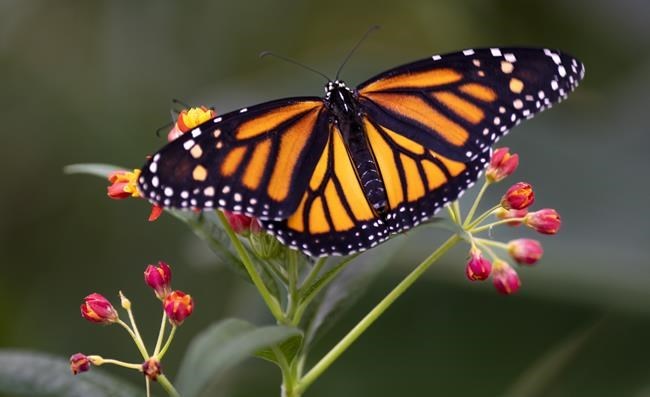
A monarch butterfly is seen in the Insectarium in Montreal, on Wednesday, November 9, 2022. A new report assessing the status of wild species in Canada says more than 2,200 plants, animals, fish and other wildlife found in Canada are at risk of dying out.THE CANADIAN PRESS/Paul Chiasson
Republished November 29, 2022 - 4:02 PM
Original Publication Date November 29, 2022 - 10:06 AM
OTTAWA - The latest report assessing the status of wildlife across Canada paints a picture of nature in crisis, biodiversity experts said Tuesday.
It comes just as Canada is readying to host a major biodiversity conference in Montreal aimed at negotiating a global agreement to protect nature, similar to how the Paris agreement is intended to halt global warming.
"Extinction is a very chilling word," said Liberal MP Terry Duguid, parliamentary secretary for environment and climate change.
"Once something is gone, it is gone forever. So the clock is ticking."
Wildlife Species 2020, the fifth national assessment ranking everything from mammals and birds to lichens and fungi, said 135 species that were at one time found in Canada are believed to be extinct, and another 4,883 are threatened in some way.
That includes 873 that are critically imperilled, mainly because of human activities that have encroached on their habitat.
In all the report has some information on more than 50,000 species in Canada, but only enough information to give a specific risk ranking to about half of them. And one-fifth of those species are considered to be at risk.
"The report lays bare some brutal truths," said Gauri Sreenivasan, director of policy at Nature Canada. "In Canada we are losing nature faster than we can recover it."
Sreenivasan and several other nature groups stressed Tuesday that the only real solution to this problem is for people to protect more natural habitat from human activity.
Canada is aiming to protect 30 per cent of its land and marine areas by 2030.
Sandra Schwartz, executive director of the Canadian Parks and Wilderness Society, said that's the bare minimum needed.
"What's ultimately needed to conserve biodiversity is to protect at least half of the Earth's land and ocean ecosystems," she said.
While the assessment itself was completed in 2020, it took almost two more years for the report to be written and then approved by the federal, provincial and territorial governments.
Many of Canada's iconic species — the beluga whale, common loon, Atlantic puffin, American beaver and the moose — are doing just fine, ranked as secure. But many more are not. The polar bear, bison, killer whale, caribou and walrus are all listed as vulnerable.
Between 2015 and 2020, 18 species became genuinely more at risk, including 11 birds, three trees, the Acadian redfish, and the yellow-banded bumblebee.
The Black Ash tree was ranked as secure in 2015, but after five years of damage from the Emerald Ash Borer, in 2020 it declined so much it's now listed as imperilled.
The species are given a ranking using 10 data points that look at things such as the range of their habitat and their known numbers over time. Species for which there is insufficient information are not ranked, such as the honeybee, the western spotted skunk and the bearded seal.
The report also notes more than 3,000 species are now in Canada that don't really belong here. They've moved in by stealth, sometimes stowing away on shipping containers, and sometimes brought purposely by people who didn't know any better.
In many cases those exotic species are contributing to the decline of natural species. They include plants like the purple loosestrife, which crowds out native plants and diminishes wetlands, affecting breeding grounds of fish and waterfowl.
While mammals often get the most attention when they're at risk, they account for less than one per cent of the known species in Canada. Eleven mammals are considered critically imperilled, including the North Atlantic right whale, the North Pacific right whale, the common grey fox and the Northern elephant seal.
The black-footed ferret is considered to be extinct, while the least shrew is believed to be extinct.
This report by The Canadian Press was first published Nov. 29, 2022.
News from © The Canadian Press, 2022